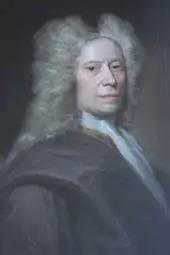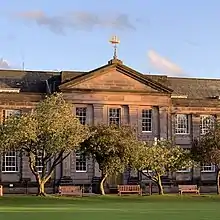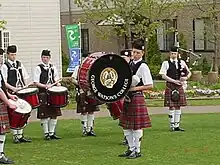George Watson's College
George Watson's College is a co-educational private day school in Scotland, situated on Colinton Road, in the Merchiston area of Edinburgh. It was first established as a hospital school in 1741, became a day school in 1871, and was merged with its sister school George Watson's Ladies College in 1974. It is a Merchant Company of Edinburgh school and a member of the Headmasters' and Headmistresses' Conference.
| George Watson's College | |
|---|---|
 | |
| Address | |
Colinton Road (Merchiston) , EH10 5EG Scotland | |
| Information | |
| Type | Public school Co-educational, private |
| Motto | Ex Corde Caritas (Love from the Heart) |
| Established | 17 May 1741 (as George Watson's Hospital) |
| Founder | George Watson |
| Principal | Melvyn Roffe[1] |
| Age | 3[1] to 18[1] |
| Number of pupils | 2,358[1] |
| Area | 50 acre[2] |
| Campus type | Urban parkland |
| Houses | Cockburn-Greyfriars, Lauriston, Melville-Ogilvie, Preston-Falconhall |
| Colour(s) | Maroon, white |
| Sports | Rugby, hockey, cricket, rowing, badminton, squash, football, sailing, rifle shooting, skiing, athletics, tennis, rock climbing, polo, surfing, fencing, curling, chess. |
| Rival | George Heriot's School |
| Publication | The Watsonian, Caritas, Recorder, Tick Talk[3] |
| Alumni | Watsonians |
| Website | gwc.org.uk |
 | |

History

Foundation
The school was established according to the instructions of George Watson (1654–1723) who bequeathed the bulk of his fortune of £12,000 – a vast sum in 1723 – to found a school for the provision of post-primary boarding education. George Watson, since 1696, had been clerk to Sir John Dick.
Unlike his father, John Watson, George was not a member of the Merchant Company of Edinburgh, but he was impressed by their co-founding and running of the Merchant Maiden Hospital (a girls school founded in 1707) and so he chose the Company to implement the terms of his will to create an equivalent facility for the sons of merchants. After some years, the Governors bought land known as Heriot's Croft, located off Lauriston Place in Edinburgh, close to the Meadows and opposite George Heriot's School, and engaged an architect. The foundation stone was laid on 22 May 1738, and the building was completed early in 1741. (At the time, there was concern that this site was too far from the city, but today it would be regarded as close to the city centre.)
The school opened as George Watson's Hospital on Whitsunday, 17 May 1741. The initial roll consisted of 11 boys, aged 9–10 years; by 1749 there were 30, while in 1842 pupils numbered 86, this figure being maintained until the end of the Hospital system in 1870.[4]
In accordance with Watson's will, the governors were responsible for former pupils up to the age of 25; they were helped to find apprenticeships and paid an allowance. Watson's stated preference was for allowing the hospital's charges to become skilled workers, though the governors also allowed boys who showed an ability to pursue medicine or academia.[5]
Transatlantic slave trade
Research in 2020 revealed that there is a strong likelihood that part of George Watson's fortune was acquired in the transatlantic slave trade.[6][7] The college states that they are "moving forward in the acknowledgement of aspects of our heritage which have previously been ignored",[6] and have conducted discussions with parents pupils and others on the "important and troubling questions about George Watson".[6]
Re-establishment as a day school
By the 1860s, the hospital school system had fallen into general public disrepute, while the Merchant Company was fearful both of government intervention in the schooling system. The solution was to re-found Watson's, and the three other hospitals under its governorship, as day schools. In July 1868 the Company applied to Parliament for powers to re-organise their schools and make different use of their endowments to as to make education more widely available.
Watson's was thus completely transformed, reopening on 26 September 1870 as a fee-paying day school with a roll of 800 boys, initially called George Watson's College Schools for Boys.
In 1869, the original hospital building was sold to the Royal Infirmary of Edinburgh. When the infirmary sought to expand in 1871, the school moved a short distance west to the former Merchant Maiden Hospital building in Archibald Place. The original hospital building was incorporated into the infirmary, and the chapel remained in use as the hospital chapel until the infirmary was itself moved away. The remains of the building were demolished in 2004 during the redevelopment of the infirmary site by the Quartermile consortium,[5] which also redeveloped the site of the Archibald Place buildings, which had been demolished in the 1930s after the school moved to its present site.
In 1902 the College was the first prestigious Scottish secondary school to appoint a woman head. The school's staff were mainly men and there were 930 pupils.[8] Charlotte Ainslie was an ex-pupil who had studied at Bedford College and now led George Watson's Ladies' College.[9]
1932 buildings

In the years following World War I, the Edinburgh Royal Infirmary needed to expand once more and was interested in the site then occupied by Watson's. At the same time, the Archibald Place building was cramped and in need of modernisation, as well as being distant from the school's playing fields at Myreside. In 1924 the Merchant Company announced that they had taken the decision to sell the Archibald Place building to the Infirmary for a "fair" price.
In 1927, agreement was made to acquire the site of Merchiston Castle School – adjacent to the Myreside playing fields – and a competition was held to design the new school building. The winner was announced in June 1928 as James B Dunn, himself a Watsonian, with a plan described as "simple, direct and masterly".
Building work on the new site commenced in August 1929. The new building, facing Colinton Road, was in a neo-classical style and sandstone-faced. It is H-shaped, extending over two stories, with a large central Assembly Hall which seats up to 1835.
The new building was completed in 1932. It was opened on 22 September by HRH Prince George (later Duke of Kent).
In October 1962, the school launched and appeal for £230,000 to meet the cost of building extensions.[10]
The Golden Jubilee of the creation of the 1932 buildings fell in 1982, and was marked by a number of celebrations. These culminated on 29 June with a visit from Her Majesty Queen Elizabeth. The Queen spent two hours touring the campus, including a short concert, and she unveiled a commemorative plaque.[5]
George Watson's Ladies College

The reforms, which saw the hospital's transformation into a day school, also saw the Merchant Company wish to open a school for girls. In July 1868, the Company applied to Parliament for powers to reorganise their schools and make different use of their endowments so as to make education more widely available.
In February 1871, the Company took over the lease of Melville House in George Square, Edinburgh and used it as the location of the nascent George Watson's College Schools for Young Ladies. It was renamed to George Watson's College for Ladies in 1877, and to George Watson's Ladies College in 1890.[5]
Amalgamation

In 1967, the Merchant Company announced its plan to combine the two Watson's Colleges to form a single co-educational campus in Colinton Road. Building work was required to house the combined school.
The first joint assembly of the amalgamated school was held on 1 October 1974. The school found itself in the Guinness Book of Records as the largest co-educational school in Scotland, with a roll of over 2,400 pupils.[5]
Since then the school has remained co-educational, and now serves day pupils only; previously various boarding houses (nick-named "bug-huts") were maintained from time to time in the Spylaw Road area, and on-campus at New Myreside House.
George Watson's College also incorporates the once entirely separate John Watson's School, the former premises of which now house the Scottish National Gallery of Modern Art.

Notable alumni
Former pupils are referred to at the school as Watsonians. According to the Sutton Trust, the school is placed first in Scotland and joint 29th in the United Kingdom for the number of the nation's leading people produced.[11]
- Henry Matthew Adam (1911–2004) – expert on histamines
- John William Ballantyne (1861–1923) – obstetrician and pioneer of female education in the field of medicine
- Rose Ethel Bassin (1889–1974), folklorist, music educator, biographer
- Sir John Flett (geologist) (1869–1947), KBE, FRSE, FRS, FGS
- James Dalgleish Hamilton Jamieson (1875–1966), FRSE – dentist and academic author
- Joseph Wedderburn (1882–1948) – mathematician
- Prof Neil Campbell (1903–1996) – chemist
- Norman Davidson (1911–1972), CBE – biochemist
- Janette Dunlop (1891–1971) – physicist
- John Alexander Loraine (1924–1988), FRSE – endocrinologist
- Stan Paterson (1924–2013) – glaciologist
- George Hector Percival (1902–1983) - physician and president, British Association of Dermatologists
- John Steele (1926–2013) – oceanographer
- Gerald Russell (b. 1928)) – Professor of Psychiatry
- Ian R. Porteous (1930–2011) – mathematician
- Keith Moffatt (b. 1935) – physicist
- Ian Frazer (b. 1953) – Creator of the Human Papilloma virus vaccine and Australian of the Year 2006
- Agnes Yewande Savage (1906–1964), pioneer woman in medicine in West Africa
Media and arts
- Finlay Currie (1878–1968) – actor
- Charles Alexander Malcolm (1881–1961), FRSE – legal librarian and historical author
- Jimmy Finlayson (1887–1953) – actor
- David Kennedy Fraser (1888–1962), FRSE – educator
- Rebecca West (1892–1983) – writer and campaigner
- Douglas Percy Bliss (1900–1984) – painter
- Henry Raeburn Dobson (1901–1985) – painter
- Robin Williamson (b. 1943) – musician with The Incredible String Band
- Ian Anderson (b. 1947) – musician with Jethro Tull
- Donald Runnicles (b. 1954), OBE – noted conductor
- Martha Kearney (b. 1957) – BBC broadcaster and journalist
- Peter Baikie (b. 1957) – Scottish comedian and composer
- Malcolm Martineau (b. 1960) – pianist and recital accompanist
- Jack Docherty (b. 1962) – Scottish writer, actor, presenter and producer.
- Paul Nuki (b. 1964) – Global Health Security Editor at The Telegraph.
- Jamie Drummond (b. 1971) – Edinburgh-born Canadian sommelier and journalist.
- Karin Giannone (b. 1974) – Journalist and news presenter at BBC News
- Hugo Rifkind (b. 1977) – journalist and columnist for The Times, The Spectator, BBC Radio 4
- Myles MacInnes (known as Mylo) (b. 1978) – singer-songwriter, music producer, and DJ
Law
- Sir John Ireland Falconer (1879–1954) – WS
- Sir John Charles Fenton (1880–1951) – lawyer, Solicitor General for Scotland
- Robert Horne, 1st Viscount Horne (1871–1940) – Chancellor of the Exchequer
- Thomas Cooper, 1st Baron Cooper of Culross (1892–1956) – Solicitor General for Scotland, Lord Advocate
- Iain Macphail, Lord Macphail (1938–2009)
- Robert Reed, Lord Reed – President of the Supreme Court of the United Kingdom
- Alastair Campbell, Lord Bracadale (b. 1949) – QC
Politics
- David Maxwell Fyfe, 1st Earl of Kilmuir (1900–1967), GCVO, PC, QC – Barrister, Home Secretary and Lord Chancellor
- Tun Dato' Sir James Beveridge Thomson (1902–1983), KBE, SSM, PMN, PJK – lawyer and judge, Chief Justice of the Federal Court of Malaysia.
- Sir Robert Brown (Robin) Black (1906–1999), GCMG – Governor of Hong Kong, 1958–64
- Ronald King Murray, Lord Murray (1922–2016), PC – politician and judge, (Labour Party)
- William Wolfe (1924–2010) – politician
- John Corrie (b. 1935) – politician, MP, MEP
- David Steel, Baron Steel of Aikwood (b. 1938), KT, KBE, PC – politician (Liberal Democrats), MP, former leader of the Liberal Party
- Sir Malcolm Rifkind (b. 1946), KCMG, QC – politician (Conservative Party)
- Malcolm Chisholm (b. 1949) – politician
- Chris Smith, Baron Smith of Finsbury (b. 1951), PC – former British MP and Cabinet minister (Labour Party)
- Colin Boyd, Baron Boyd of Duncansby (b. 1953), PC, QC – Lord Advocate, life peer in the British House of Lords
- Frances Guy (b. 1959) – Diplomat, British Ambassador to the Yemen and Lebanon
- Liz Smith (b. 1960) – MSP for the Scottish Conservative Party
Military
- Captain Henry Peel Ritchie (1876–1958) – First World War Victoria Cross recipient
- Rear Admiral George Pirie Thomson (1887–1965), CBE – naval officer and Britain's Chief Press Censor in WWII
- Major-General Sir Alexander Biggam (1888–1963), KBE, CB, FRSE, FRCPE, FRCP
- Air Chief Marshal Sir James Robb (RAF officer) (1895–1968), GCB, KBE, DSO, DFC, AFC
- Lieutenant General Sir David Young (British Army officer) (1926–2000), KBE, CB, DFC
Religion
- The Reverend David Arnott – Moderator of the General Assembly of the Church of Scotland for 2011–2012
Sports
- William Stuart (1889–1917) – cricketer
- James Martin (1901–1988) – cricketer
- Leslie Craig (1904–1971) – cricketer
- William McNab (1916–1989) – cricketer
- John Howard Wilson (1930–2015) – rugby player
- Robin Smith (1938–1962) – mountaineer
- Ian Robertson (b. 1945) – rugby player and commentator
- David Johnston (b. 1958) – international rugby player and professional footballer (Heart of Midlothian)
- Gavin Hastings (b. 1962), OBE – rugby player
- Scott Hastings (b. 1964) – rugby player
- Martin Bell (b. 1964) – skier, and four times participant of the Winter Olympics
- Keith Fraser (b. 1968) – skier, Olympic Athlete 1992
- Sir Chris Hoy (b. 1976), MBE – Six-time Olympic gold medal winning track cyclist
- Neil McCallum (b. 1977) – cricketer
- Jason White (b. 1978) – rugby player
- Marcus Di Rollo (b. 1978) – rugby player
- Gillian Cooke (b. 1982) – athlete and bobsledder
- Craig Sutherland (b. 1988) – professional footballer
- Stuart McInally (b. 1990) – rugby player [12]
- Josh Kerr (b.1997) – middle-distance runner [13]
- Callum McBrierty (b. 1992) - world champion rower 2016, Olympic gold medal winner, Rio 2016
- Grace Reid (b. 1996) - Olympic diver
Other
- Auckland Geddes, 1st Baron Geddes (1879–1954), GCMG, KCB, PC
- Sir Basil Spence (1907–1976) – architect
- Sir Eric Anderson (1936–2020), KT, FRSE, provost and Headmaster of Eton and Shrewsbury
Notable staff
- Charlotte Ainslie OBE – first woman head at a prestigious Scottish school.[9]
- William Dickson FRSE (1905–1992), Head of Science. The only schoolteacher to have been elected a Fellow of the Royal Society of Chemistry.
- Andrew J G Barclay and Alexander Yule Fraser, Maths masters, joint founders of the Edinburgh Mathematical Society
- Peter Pinkerton FRSE – maths master, 1903 to 1913[14]
- Robert Taylor Skinner FRSE taught mathematics in the school 1893 to 1899[15]
- Elspeth Janet Boog Watson - Writer and broadcaster. Sometime head of history department at George Watson's Ladies College.
- Anum Qaisar - MP for the SNP who taught Modern Studies.
References
- "George Watson's College". Scottish Council of Independent Schools. Retrieved 19 January 2015.
- "Our School". George Watson's College. Retrieved 19 January 2015.
- "School Publications". George Watson's College. Retrieved 19 January 2015.
- Waugh, Hector Liston (1970). George Watson's College. George Watson's College. ISBN 9780950183800.
- Howie, Les (2006). George Watson's College: An Illustrated History. George Watson's College. pp. 1–270. ISBN 978-0-9501838-2-4.
- "Heritage - George Watson's College". www.gwc.org.uk. Retrieved 11 October 2023.
- "The Legacy of George Watson - George Watson's College". www.gwc.org.uk. Retrieved 11 October 2023.
- Elizabeth L. Ewan; Sue Innes; Sian Reynolds; Rose Pipes (8 March 2006). The Biographical Dictionary of Scottish Women. Edinburgh University Press. p. 7. ISBN 978-0-7486-2660-1.
- Lindy Moore, ‘Ainslie, Charlotte Edith (1863–1960)’, Oxford Dictionary of National Biography, Oxford University Press, 2004 accessed 11 June 2017
- "Reshaping Gorge Watson's. Appeal Launched for £230,000". The Glasgow Herald. 23 October 1962. p. 4. Retrieved 8 January 2022.
- "The Educational Backgrounds of the Nation's Leading People" (PDF). Sutton Trust. Retrieved 31 July 2019.
- "Stuart McInally".
- "Josh Kerr". 27 April 2020.
- Biographical Index of Former Fellows of the Royal Society of Edinburgh 1783–2002 (PDF). The Royal Society of Edinburgh. July 2006. ISBN 0-902-198-84-X.
- Biographical Index of Former Fellows of the Royal Society of Edinburgh 1783–2002 (PDF). The Royal Society of Edinburgh. July 2006. ISBN 0-902-198-84-X.